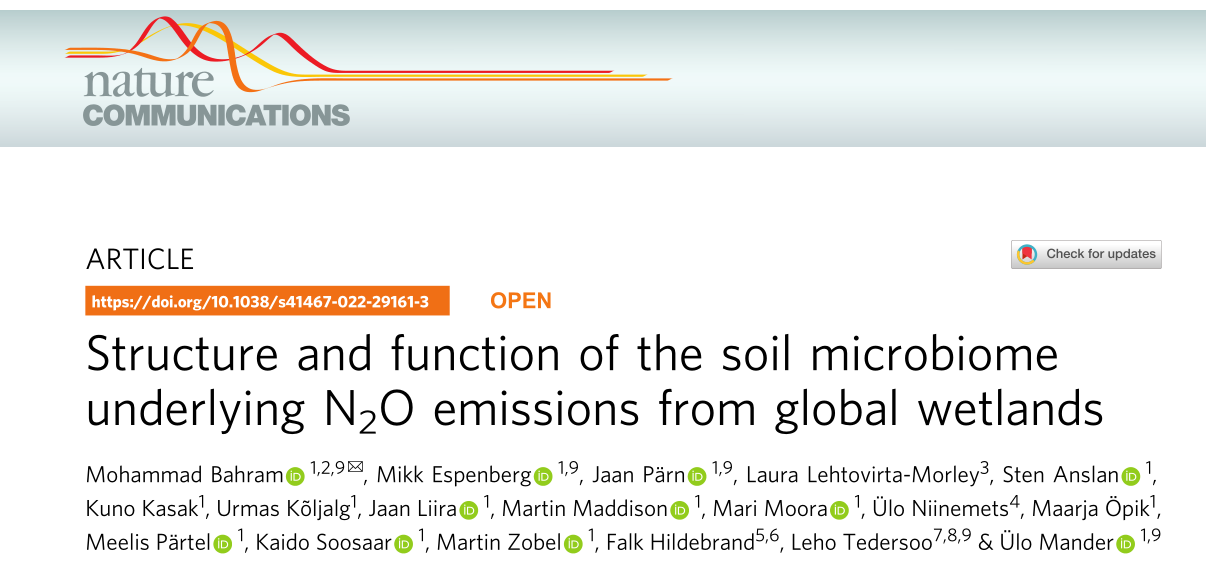尽管湿地只覆盖了陆地表面的8%,但湿地土壤(包括潜育土和泥炭土)占全球有机碳储量的很大一部分。碳和氮的微生物降解会导致温室气体的大量释放,其中N2O是一种强有力的温室气体,其全球变暖潜力是CO2的265倍。为了降低湿地土壤的N2O释放,我们需要深入了解塑造氮循环和N2O动力学相关的微生物活动的生化路径以及重要的环境因子。
Despite covering only 8% of the terrestrial Earth surface, wetland soils (including gley and peat soils) store one of the largest organic carbon (C) stocks. Microbial degradation of C and nitrogen (N) stocks can lead to substantial releases of greenhouse gases (GHGs), including nitrous oxide (N2O). N2O is a potent GHG with a global warming potential 265 times that of CO2. To reduce N2O emissions from wetland soils, we need a thorough understanding of biogeochemical pathways and critical environmental parameters, which shape the microbial activities underpinning the N cycle and N2O dynamics.
2022年3月17日,以Mohammad Bahram为第一作者的主要研究人员在《Nature Communications》上发表了一篇名为“Structure and function of the soil microbiomeunderlying N2O emissions from global wetlands”的研究论文。通过采用原位N2O测量、测定全球645个湿地的土壤微生物的结构与潜在功能,作者评估了古菌、细菌以及真菌在氮循环以及N2O释放中扮演的潜在角色。
On March 17, 2022, Mohammad Bahram, as the first author, published a paper entitled “Structure and function of the soil microbiome underlying N2O emissions from global wetlands” in Nature Communications. Using in situ N2O measurements and by determining the structure and potential functional of microbial communities in 645 wetland soil samples globally, we examined the potential role of archaea, bacteria, and fungi in nitrogen (N) cycling and N2O emissions.

研究数据表明更温暖的土壤和更剧烈的土地利用变化可能增强湿地土壤的N2O释放。同时,N2O释放与土地利用类型显著相关,最大值出现在裸露土壤,最小值出现在森林土壤。
The analysis indicated that warmer soils and more intensive land use progressively may enhance N2O release from wetland soils. N2O emissions showed exponentially increasing relationships with temperature of the warmest month. In addition, the N2O emissions were strongly explained by land-use type, with greatest values in the bare soils and lowest in the forest soils.

图1不同土地利用类型中与古细菌硝化菌相关的全球N2O通量热点
Fig. 1: Global hotspots of N2O fluxes in relation to archaeal nitrifiers across various land use types
气候与土壤因子对湿地土壤微生物(包括古菌、细菌和真菌)多样性的影响最显著。古菌的多样性取决于土壤C/N比例;土壤pH是细菌最主要影响因素;而真菌多样性与环境因素关联性最弱。
Climate and soil variables had the greatest impact on microbial diversity. Archaeal diversity was best explained by soil C/N ratio. Soil pH was the primary determinant of bacterial diversity, whereas fungal diversity showed a weak relationship with environmental factors.

图2全球湿地土壤中主要古细菌、细菌和真菌门(变形菌纲)的环境预测因子
Fig. 2: Environmental predictors of major archaeal, bacterial and fungal phyla (class for Proteobacteria) across the global wetland soils
在所有潜在的N2O释放相关的古菌的重点基因群中,古菌amoA基因的相对丰度与N2O释放的相关性最强。
In all major archaeal genetic group released by N2O, there is a strong association between the archaeal amoA gene abundance and N2O emission

图3古细菌和古细菌amoA与全球湿地土壤中的N2O密切相关
Fig. 3: Archaea and archaeal amoA strongly correlate with N2O across global wetland soils
发现N2O释放的增加与参与氮循环功能基因多样性增加有关。这一现象可能是由于氮相关过程之间的互补,尤其是反硝化和硝化过程均能产生N2O。这一互补发生在干涸的湿地土壤,这类湿地土壤会经历不同的缺氧和好氧条件,硝化微生物产生的硝氮能够作为反硝化过程的底物。
higher N2O emissions with increasing diversity of N cycle functional genes. The greater N2O emissions with increased functional gene diversity can be related to the functional complementarity of different N-related processes, in particular denitrification and nitrification, in producing N2O.This can occur in drained wetland soils with a variety of anoxic and oxic conditions, where nitrifiers may contribute to the generation of nitrate required for denitrification.

图4氮循环基因是解释全球湿地土壤N2O排放的主要因素
Fig. 4: Nitrogen-cycle genes as the main factors explaining N2O emissions across the global wetland soils
总而言之,本文发现硝化微生物对N2O释放的贡献比先前预想的高,同时,氮循环相关的微生物多样性可以作为N2O释放的综合预测因子。为了解全球N2O排放的潜在机制,我们需要了解各种生境类型中硝化和反硝化的相对作用,以及气候、植被和土地利用的影响。此研究预测,未来湿地土壤的排水和变暖将通过加速古菌硝化作用,增加反硝化作用的底物可用性,从而共同促进N2O排放,对调节湿地生态系统服务产生负面影响。
The results suggest that nitrifying microbes may contribute more strongly to N2O emission than previously thought, and that the diversity of microbes involved in the N cycle may be the integral predictor of N2O emissions. To determine the mechanisms underlying global N2O emissions, we need to understand the relative role of nitrification and denitrification across a broad variety of habitat types as well as the effects of climate, vegetation, and land use. We predict that future drainage and warming of wetland soils will have negative consequences for regulating ecosystem services of wetlands through accelerating archaeal nitrification that increases substrate availability for denitrification, which collectively promote N2O emission.
原文链接:https://doi.org/10.1038/s41467-022-29161-3